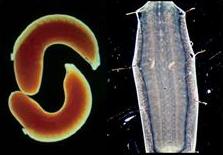| |
Experimental Protocols
Embryo Medium
Embryonic Ganglia
Luria Broth
50x TAE
Antibody Staining
Pond Water
|
 |
 |
Preparation of Embryonic Ganglia in a Collagen Matrix
Protocol for Culturing of Embryonic Ganglia in a Collagen Matrix:
(adapted 07-01-04 by Michael Baker from S. Blackshaw et al., (1997). Proc. R. Soc. Lond. B. 264: 657-661)
Reagents & Prior Preparations:
- Acid washed and concavalin A coated coverslips or equivalent.
- L-15 Embryonic culture media with supplements according to recipe by Birgit Zipser (see culture media description).
Media should always be made fresh or frozen and then supplemented with growth factors, glutamine and Vitamin C
as Vitamin C and glutamine are not stable in solution.
- Rat tail collagen type I (e.g. BD BIOSCIENCES Catalog Number: 354236).
- 7.5 % sterile filtered solution Na2C03.
- 10X sterile filtered L15 made from powder.
- Collagen/Dispase 22 mg/ml stock (~10x).
- 35 mm covered petri dishes or equivalent for holding coverslips and culture media.
- Fire-polished glass capillaries with attached tubing and mouth piece for suction. The inner diameter of
capillary should be approximately 10% larger than long-dimension of individual ganglia to be plated.
Protocol:
- Pin out embryo on Sylgard dish with the dorsal side up. Remove sinus surrounding CNS with sharpened tungsten wire.
With scissors or equivalent fine cutting tool, cut connectives between ganglia and remove isolated ganglia with
gentle suction and careful tearing/cutting of the lateral roots. Place ganglia in drop of L15.
- Partial collagenase digestion of the capsule may improve outgrowth (Subhas Biswas; personal communication). Add
collagenase (~1-2 .l of a 20mg/ml stock solutionn) to droplet of L15 and transfer ganglia by suction to the
drop (I routinely digest for between 5 and 10 min). If collagenase is used, careful and repeated washing of
the ganglia will be required (by using repeated pipeting and collection and transfers to fresh L15 droplets).
- On ice, prepare collagen solution for plating. Collagen is stored and maintained in solution by keeping it in
0.02 N Acetic Acid. Gelling characteristics of collagen determined by temperature, concentration and pH
(it begins to gel as it approaches neutrality). Empirical testing with collagen solutionn from BD BIOSCIENCE
suggests that their product will gel with increasing degrees of hardness beginning at around 50% collagen in
solution. I have used it in a 9:1 dilution (adding 10 microliters of 10X L15 (no supplements) to 90 microliters
of collagen and mixing it in an eppindorf tube by pippeting carefully so as to not introduce air bubbles. Sodium
bicarbonate solution is then added until the phenol red indication goes from clear-yellow to pink red indicating
a pH near neutral. Careful mixing is required (usually 2-3 microliters of Na2C03. Solution is kept on ice until
ready for use.
- On a glass coverslip add 20-30 microliters of collagen-L15 solution, taking care not to introduce bubbles and
spreading it out with micropipet tip until desired depth is obtained (suggested twice thickness of individual
ganglion, .100 µm).
- Transfer the ganglia with suction capillary into Collagen-L15 droplet. Care should be taken so as to not dilute
collagen solution with further L15 from the ganglia-droplet (some dilution will of course be unavoidable).
Ganglia should be placed/pressed into the collagen solution making sure that surface tension does not hold
them to the surface. Leave covered in a darkened-humidifying chamber for approximately 30 min-1 hour until
collagen has gelled. Carefully add supplemented embryonic culture media (1-2 ml).
- To minimize bacterial contamination, media should be exchanged daily by careful removal at side of dish.
|

